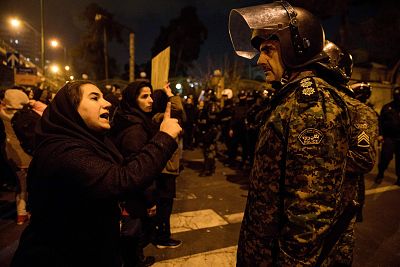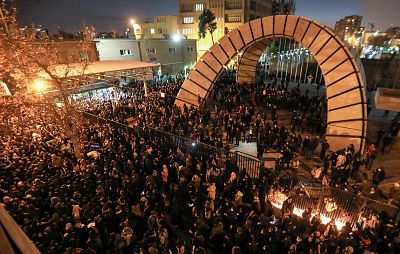"Iranian protesters are likely very aware that the Iranian regime uses legitimate grievances against the United States and Israel to deflect criticism."
A week after millions of Iranians flooded the streets following the death of one of the country's top generals, Qassem Soleimani, a contrasting symbolic image played out in Tehran on Sunday.Crowds of people outside Beheshti University refused to trample over giant U.S. and Israeli flags that had been painted on the ground, according to video filmed at the scene that has been verified by NBC News.This appeared to be a symbolic gesture, given that walking on, or burning, these flags has been a feature of previous demonstrations.Encouraging marchers to do the same may have been why they were painted in the street outside the university. And declining to comply was likely one way for the protesters to send a message to the government, according to H.A. Hellyer, a senior associate fellow at the Royal United Services Institute, a think tank in London."Iranian protesters are likely very aware that the Iranian regime uses legitimate grievances against the United States and Israel to deflect criticism," said Hellyer, who is also a nonresident scholar at the Carnegie Endowment for International Peace, a Washington think tank."By not stepping on their flags, they're unlikely to be showing support for the U.S. and Israel, but more just sending a message to the regime that they aren't interested in deflection," he said.
In Tehran and elsewhere, anger on the streets has been palpable. The country is in the midst of three days of angry demonstrations after the government admitted it accidentally shot down a Ukrainian International Airlines passenger jet during a military confrontation with the United States.After three days of denials, the Iranian government admitted Saturday that one of its missiles had downed the plane and killed all 176 people on board, mostly Iranians. The country had just fired missiles at U.S. forces in neighboring Iraq in retaliation for a drone strike directed by President Donald Trump that killed Soleimani.Although this admission of guilt by the government appeared to be the trigger for the protests, they have since expanded into a wider call for democratic reforms and a critique of Iran's supreme leader, Ayatollah Ali Khamenei, and others.Some of the protesters have called for Khamenei to stand down, and there have been clashes between demonstrators and security forces. One video appeared to show the aftermath of a woman being shot in Tehran, although police have denied firing at the crowds over the weekend.Another piece of footage showed a commemorative roadside banner of Soleimani that had been set alight, and elsewhere protesters were seen ripping down and stomping on posters of the dead general."Our protests were about all of the irresponsibility of the regime, not just the plane. The plane was the trigger of this protest," said Elhan, 29, one of those who took to the streets in Tehran.She asked not to publish her last name for fear of reprisals, telling NBC News by phone Monday that the demonstrators "just want a true democracy … we are so angry and sad."
It's not the first time that Iranians have made a point about refusing to disrespect the U.S. and Israeli flags. In 2016, a prominent professor, Sadegh Zibakalam, went to great lengths to avoid this — shimmying along an adjacent railing rather than walking on the ground on which they had been painted.Students in particular have employed other tactics over the years to show that they are unwilling to toe the government's line."When regime representatives shout 'death to America! death to Israel!' over a loudspeaker, the students chant back 'death to Russia! death to China!' said Gissou Nia, a human rights lawyer and a nonresident senior fellow at the Atlantic Council, a Washington think tank. "It's not because the students actually want death to those nations, it's just to show the world that they are not aligned with the regime's world view. "While refusing to walk on flags isn't new, what is significant about this weekend's protesters is that they took to the streets knowing it carried a great risk to their lives, according to Holly Dagres, a nonresident fellow also at the Atlantic Council.It was just last November when anti-government demonstrations last broke out across Iran, with people initially angry about a hike in gasoline prices but soon calling for other political freedoms.The U.S.'s special representative for Iran Brian Hook has said that more than 1,000 Iranian citizens may have been killed in the ensuing clashes. Although Iran has disputed any figures on the death toll as "purely speculative" and "highly inaccurate.""Despite knowing full well that their brothers and sisters were just killed, the protesters this week are willing to take to the streets and sacrifice their lives to have their voices heard against the Iranian government," Dagres said. "That is courageous and impressive."These demonstrations took place days after a mass outpouring of grief, or at least dissatisfaction, following Soleimani's death. The funeral procession in his hometown of Kerman was so packed that dozens of people died in a stampede.For many experts, Iran is too often seen in the West as a simple, homogeneous entity that thinks and acts in a unified manner.Of course the reality is far more nuanced in this nation of 82 million people that features many "diverse political strands," according to Arshin Adib-Moghaddam, a professor at the School of Oriental and African Studies, a university in London.













